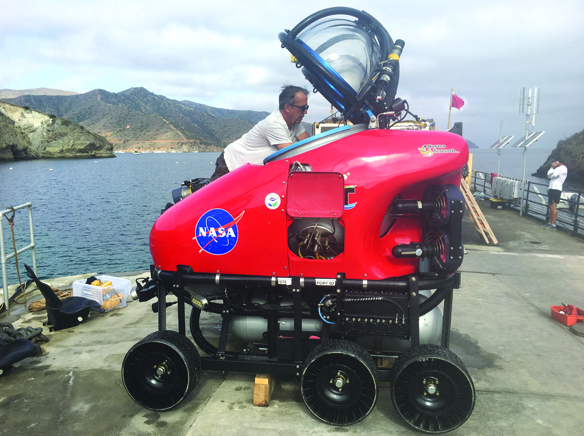Could the secrets connected to a varied geologic formation under the sea surrounding tiny Catalina Island pave the way for future exploration to Mars – and beyond?
Following a “great mission” on Catalina that ended Aug. 29, Jon Council told the Avalon city council Tuesday that “if the numbers work out, NASA could return and be here for years to come.”
Although only recently announced to the public, Council has been working quietly for more than a year, shuttling NASA personnel on and off the island, hoping to land a fully NASA sanctioned underwater test of Catalina as a training ground for deep space.
For years, NASA has operated Aquarius, an underwater laboratory in the Atlantic Ocean used to train astronauts.
According to NASA, its undersea training program is called NEEMO, an acronym for NASA Extreme Environment Mission Operations, and claims it is the world’s only undersea research station in the Atlantic Ocean off the Florida Keys.
There, astronauts train for deep space missions by living in Aquarius for weeks. They operate undersea vehicles in conditions and terrain that simulate harsh environments they expect to find on planetary voyages.
Lately, however, due to storm damage and the lack of some geologic formations in the Atlantic, Council moved quickly once he learned NASA may be interested in looking at a test in another site.
“Over a year ago, NEEMO creator and director Bill Todd reached out to me and we discussed the fact that Florida geology consists almost entirely of porous karst limestone, which are the fossilized remains of ancient coralline animals,” said Council.
Council is the founder of the award-winning Avalon Dive Exhibit (located in the Avalon Casino) and he has a long background in diving and submersibles. Council said he has known many in the NASA NEEMO program for years.
Thus, as a result of the phone call and Council’s assistance, NASA officials began visiting the island. Periodically, over a period of months, he began taking NASA visitors to key points of geologic formations and making his case for a Catalina experiment.
Key NASA officials began to methodically examine the island, its infrastructure and resources to determine if and where a mission control base of operations could be set up.
In addition to the island’s land resources, the NASA team, of course, also began “a series of undersea excursions to try to locate several possible training sites.”
“Well, as it just so happens, Catalina is one of the most geologically diverse locations in the world. Geologically speaking, Catalina Island is messed up like a soup sandwich,” he said.
Sedimentary rock, pyroclastic ejecta, twisted and distorted upheaval rifts from plate tectonics can all be found on this Southern California rocky desert island, said Council, knowing it was perfect for a NEEMO experiment on Catalina.
For a base of operations, Council also introduced them to officials at the University of Southern California’s Wrigley Institute, located near the Island’s Isthmus.
“Through that process, eventually, it became evident that all of the required elements for a NEEMO program could be satisfied at the USC Wrigley Marine Institute,” said Council.
Given the geologic variety and the potential support of the USC Wrigley Institute, NASA finally gave the Catalina experiment the green light, dubbing the project “NEEMO NXT.”
“For the first time in NASA’s long and illustrious history, a NEEMO training program was conducted in ocean waters outside of their typical Florida Keys undersea habitat location,” Council said with pride.
Engineers, divers, communication specialists and astronauts descended on Catalina. The Wrigley Institute housed up to thirty staff, feeding them, providing a large conference room space that could be transformed into a makeshift mission control center.
The Wrigley Institute’s location provided a shoreside access area for all the technology which was about to be unleashed by NASA.
The initial team members arrived mid-month to transform one of the institution’s properties into the NEEMO NXT mission control center, said Council.
He said the NASA technicians worked with “Indy pit-crew efficiency,” installing dozens of big screen computer monitors, satellite relay towers, wifi links, video camera monitors, and what seemed like miles of power and relay cables pouring out in every direction into the institute’s Boone House.
“These NASA folks…, they really know their business,” said Council.
Council said a forty-ton crane was barged in to handle small submarine deployment as part of the program and that the submersibles used were the Deepworker and Exosuit class craft manufactured and shipped in from Vancouver B.C. Canada.
The two-person Deepworker sub was modified with a compliment of six airless tires so that it could simulate an astronaut driven lunar or Mars rover vehicle.
“It proved to be an incredible simulator and useful tool,” said Council, considered a submersible expert. He said those machines represent the technological pinnacle of manned workboat submersible design available today.
As such, they are merely tools to allow human beings to reach into a hostile environment, stay alive and conduct work, he added.
Essentially, they are the vehicles to get to the job site and, in many ways, are the closest approximation or simulation to working in space or other planets with a different gravitational force or hostile atmospheric conditions, said Council.
Over the course of the experiment, NASA tested an array of new high-tech equipment; operated a task panel of “puzzle like” compressed air valves which drive a piston (when properly sequenced) or jettison bubbles to regulate experiments, indicate their success and of course, study the varied geology.
In addition, the astronauts used laser targeting equipment for image capture and used hydraulic manipulators for sample gathering, among the many experiments.
“Actually,” he said, there was “so much happening simultaneously each day that to describe it all could produce a book worth of information.”
When complete, Council said “nearly every objective laid out for the astronauts were achieved, “and because of it, the NEEMO NXT program is considered a complete success.”
Now, he said, NASA technicians are examining reams of data, video, mission logs, etc. in an attempt to further streamline the training, adjust operational protocols to maximize efficiency and create an even more effective and dynamic training program in preparation of future space exploration.
“And now Catalina Island holds the distinct honor of being part of that effort and if all goes well, future NEEMO missions may be held here as a result of this historical NASA program.”











